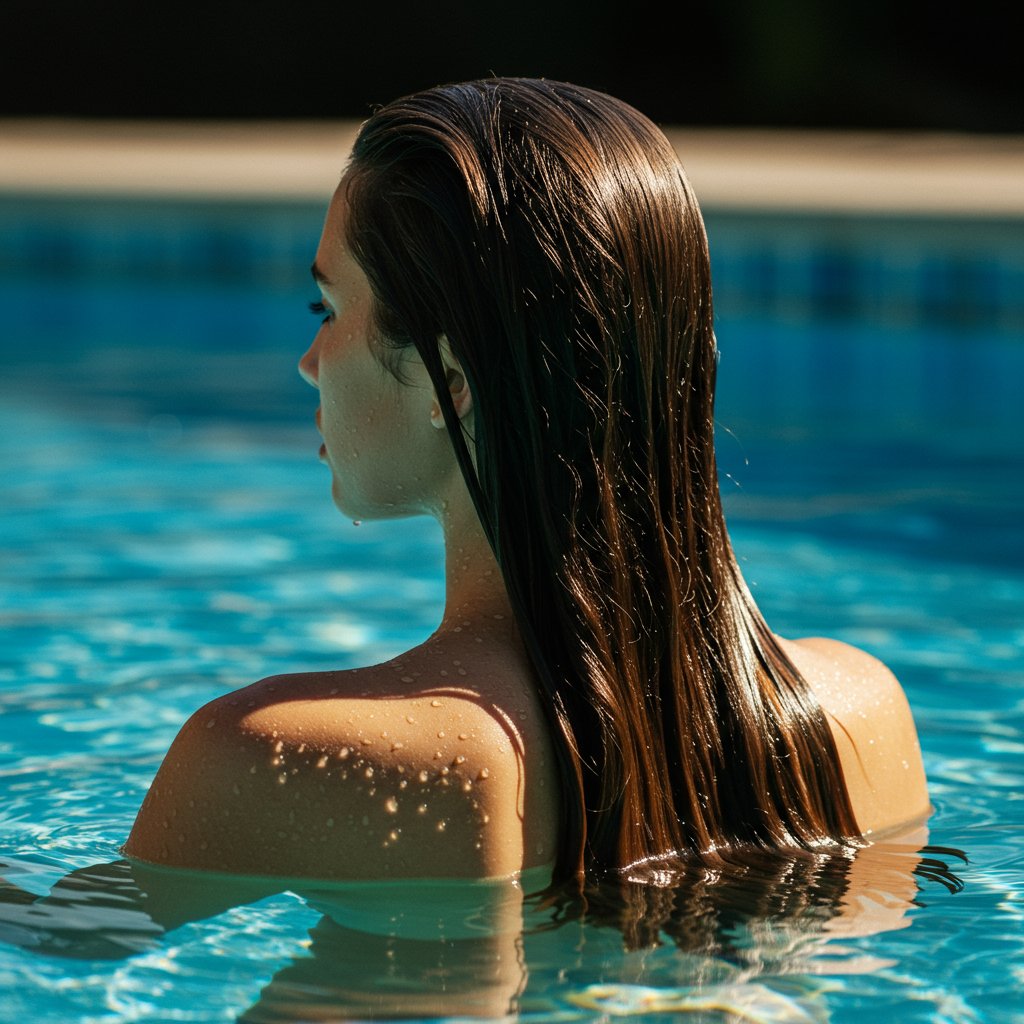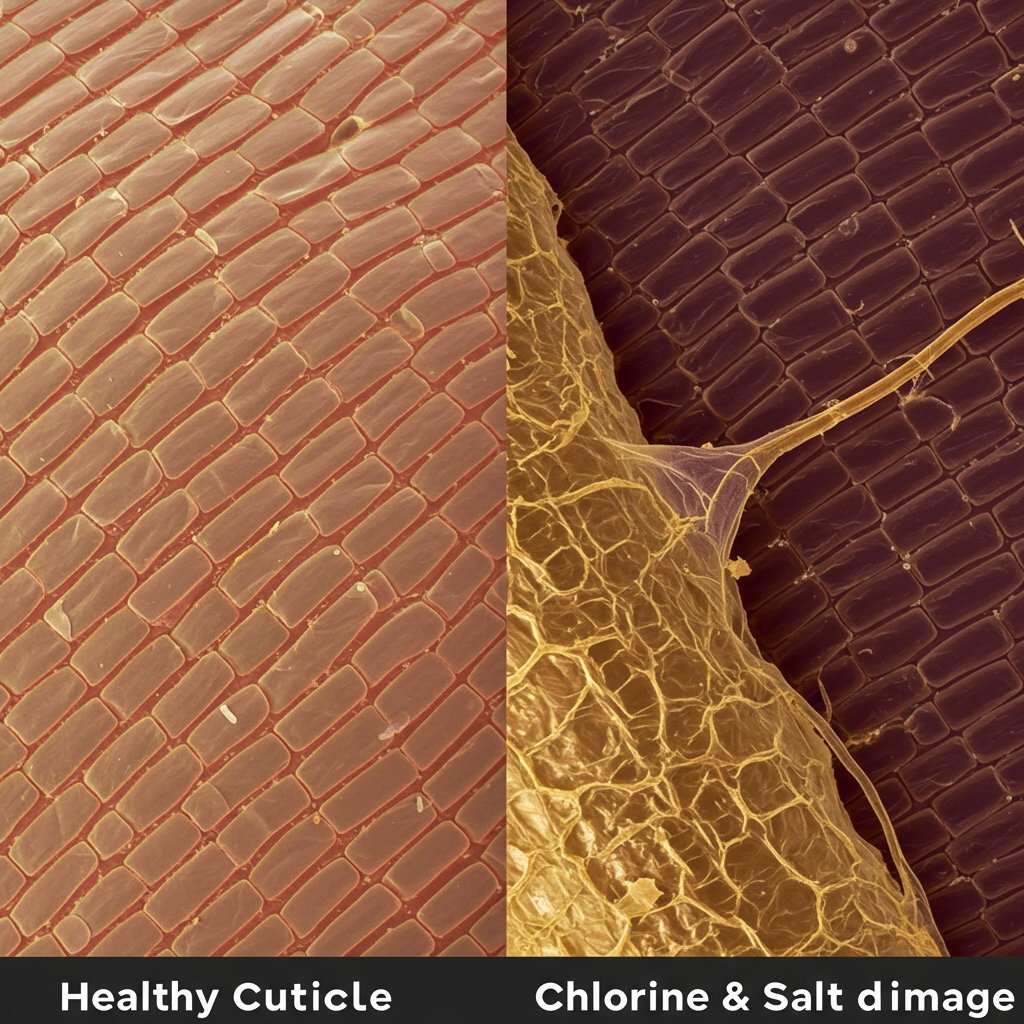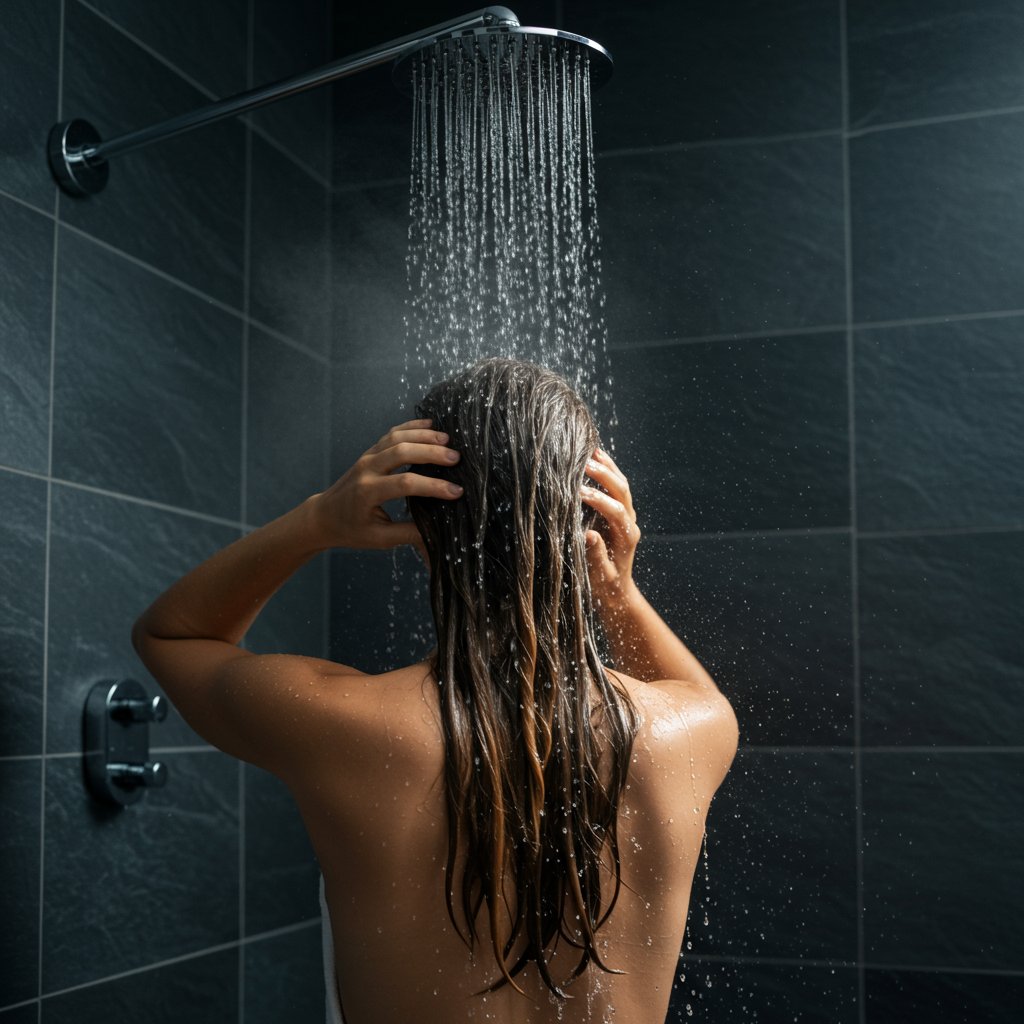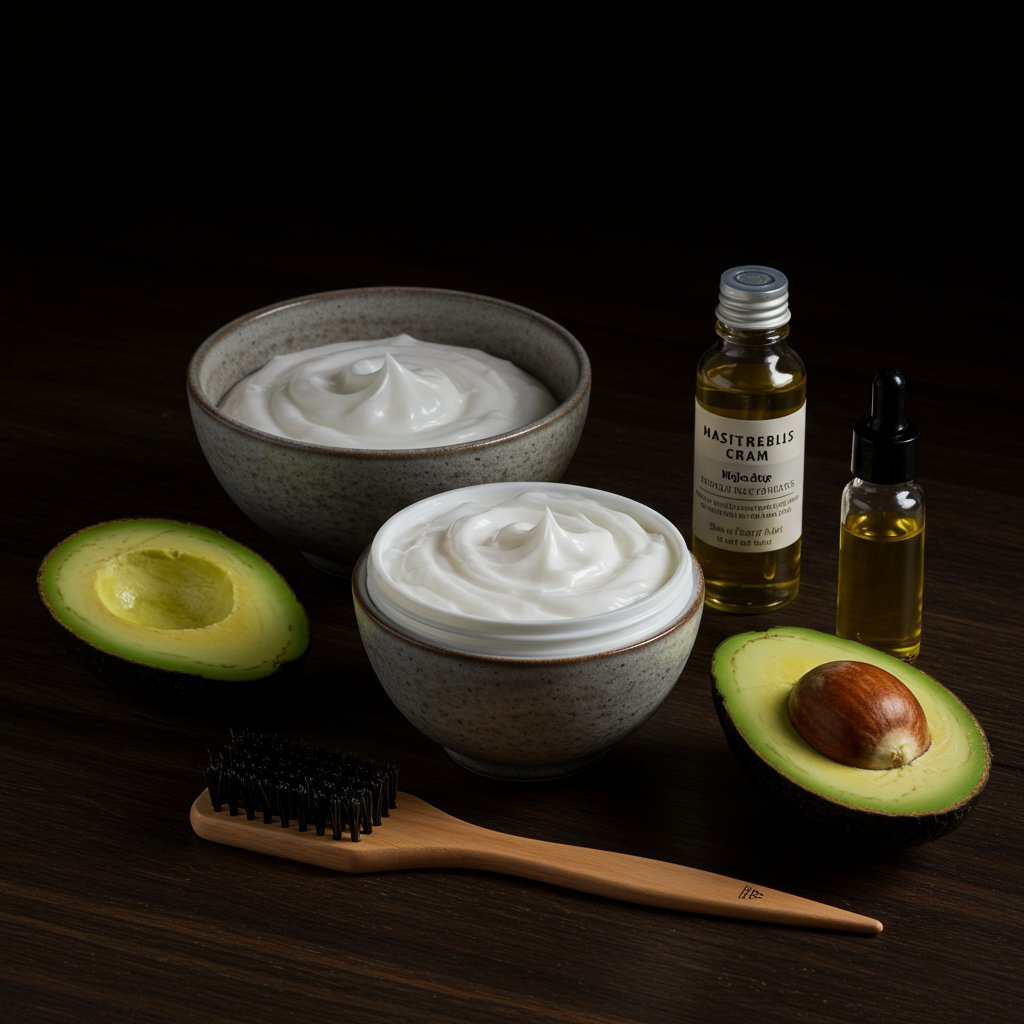Hair Care for Swimmers: A Complete Guide to Protecting Your Locks from Chlorine and Saltwater Damage
Love the Swim, Protect Your Strands
There's nothing quite like the feeling of gliding through the water—whether it's the refreshing coolness of a swimming pool on a hot day or the invigorating embrace of the ocean. For many, swimming is more than just a sport; it's a passion, a workout, and a form of therapy. But this beloved activity can be unforgiving on your hair. The constant exposure to chlorine, salt, and sun can leave your locks feeling dry, brittle, tangled, and lackluster. This comprehensive guide to hair care for swimmers is your ultimate resource for protecting your hair from the harsh elements, so you can enjoy the water without compromising the health and beauty of your tresses.

Understanding the specific challenges that chlorine and saltwater pose is the first step toward building an effective defense. Chlorine is a powerful chemical designed to sanitize, but it doesn't distinguish between bacteria and the natural oils that keep your hair supple and shiny. Saltwater, while natural, has a dehydrating effect that can be just as damaging. The good news is that with a strategic pre-swim, post-swim, and weekly care routine, you can mitigate this damage entirely. This guide will walk you through the science of hair damage, preventative measures, immediate aftercare, and restorative treatments, ensuring your hair remains as vibrant and healthy as you feel after a great swim.
The Science of Damage: How Chlorine and Saltwater Affect Your Hair
To effectively combat hair damage, it's essential to understand what's happening at a microscopic level. Both pool and ocean water alter the structure and chemistry of your hair strands, but they do so in different ways. Knowing your adversary is key to choosing the right protective and restorative products and techniques.

Chlorine's Chemical Assault
Chlorine is a disinfectant used in swimming pools to kill harmful bacteria. Unfortunately, it's also incredibly effective at stripping away your hair's natural protective layer of sebum. This oil, produced by your scalp, coats the hair shaft, sealing in moisture and providing a natural shine. When chlorine removes this barrier, the hair's cuticle—its outer layer of overlapping scales—is left exposed and vulnerable. The chemical then penetrates the hair shaft, breaking down the keratin proteins that give your hair its strength and structure. This leads to porous, weak, and brittle strands that are prone to split ends and breakage. For those with color-treated hair, chlorine can accelerate fading and, in the case of lighter hair, cause a dreaded green tint. This greening isn't caused by the chlorine itself but by its reaction with copper pipes and other metals in the water, which then oxidize and bond to the proteins in your hair.Saltwater's Dehydrating Effect
Swimming in the ocean presents a different, albeit equally challenging, scenario. Salt is hygroscopic, meaning it attracts and absorbs water. When you swim in the sea, the high salt concentration in the water draws moisture out from the inside of your hair strands. This process of osmosis leaves your hair severely dehydrated, rough, and frizzy. While saltwater can add some beachy texture and volume in the short term, prolonged exposure without proper care will result in significant dryness and tangling. The salt crystals that remain on your hair as it dries can also create friction between strands, leading to mechanical damage and breakage. Combined with the sun's UV rays and the wind, a day at the beach can create the perfect storm for hair damage if you're not prepared.Pre-Swim Prep: Your First Line of Defense
The old adage, "an ounce of prevention is worth a pound of cure," is especially true for swimmer's hair care. The steps you take before you even touch the water are the most critical in minimizing damage. Creating a barrier between your hair and the harsh chemicals or salt is your primary goal.

Saturate with Clean Water
Think of your hair like a sponge. A dry sponge will quickly soak up any liquid it comes into contact with, but a sponge that's already saturated can't absorb much more. The same principle applies to your hair. Before getting into the pool or ocean, thoroughly rinse your hair with clean, non-chlorinated tap water. This simple step allows your hair shafts to absorb the fresh water, leaving less room for chlorinated or saltwater to penetrate and cause damage. It's a quick, free, and incredibly effective first line of defense that every swimmer should adopt.Create a Protective Barrier
After rinsing, the next step is to coat your hair with a protective product. This adds another layer of defense, sealing the cuticle and preventing chemicals and salt from latching on. A generous application of a waterproof leave-in conditioner is an excellent choice. Alternatively, natural oils like coconut oil or argan oil work wonderfully, as they are hydrophobic (repel water) and form a slick barrier. There are also specialized pre-swim hair products formulated with ingredients like silicones and polymers that are specifically designed to shield hair from chlorine and salt. Apply your chosen product from root to tip, ensuring every strand is coated.The Ultimate Shield: The Swim Cap
For serious and frequent swimmers, a swim cap is non-negotiable. While it may not keep your hair 100% dry, it is by far the most effective physical barrier against water. Silicone caps are generally considered the best option as they are durable, flexible, and less likely to pull or snag your hair compared to latex. To maximize its effectiveness, first tie your hair back in a low bun or braid, then put on the cap. For extra protection, apply your leave-in conditioner or oil before tucking your hair into the cap. This combination of a chemical barrier (product) and a physical barrier (cap) provides the ultimate protection for your locks.Post-Swim Rescue: Immediate Aftercare is Crucial
What you do immediately after your swim is just as important as your pre-swim prep. The goal is to remove any lingering chlorine, salt, and mineral deposits as quickly as possible and begin the process of replenishing lost moisture and nutrients.

Rinse Immediately and Thoroughly
As soon as you exit the water, head for the nearest shower and rinse your hair thoroughly with clean, fresh water. This crucial step washes away the majority of the damaging chemicals and salt before they have more time to wreak havoc. Don't wait until you get home; the longer chlorine and salt sit on your hair, the more moisture they will strip away. Even a quick 30-second rinse is significantly better than doing nothing at all. Use your fingers to gently work the water through your hair from scalp to ends to ensure a comprehensive rinse.Cleanse with a Targeted Shampoo
After rinsing, it's time to wash your hair with a shampoo specifically formulated to address the needs of swimmers. Look for either a "swimmer's shampoo" or a "clarifying shampoo." These products contain ingredients like EDTA or phytic acid that act as chelating agents, which means they bind to chlorine and mineral deposits (like copper) and wash them away. This is essential for preventing buildup and the dreaded green tint. However, clarifying shampoos can be drying themselves, so they should be used strategically—only on swim days or once a week for frequent swimmers. Always follow up with a deeply hydrating conditioner.Follow with a Hydrating Conditioner
Shampooing opens up the hair's cuticle to clean it; conditioning seals it back down while replenishing moisture. After using a clarifying shampoo, it's vital to use a rich, moisturizing conditioner. Look for products containing ingredients like glycerin, hyaluronic acid, shea butter, panthenol (pro-vitamin B5), and natural oils. Apply the conditioner generously, focusing on the mid-lengths and ends where hair is oldest and most prone to dryness. Leave it on for at least 3-5 minutes to allow it to penetrate the hair shaft before rinsing with cool water to help seal the cuticle and lock in moisture.Weekly Restoration Rituals: Deep Conditioning and Treatments
For those who swim regularly, a simple wash-and-condition routine isn't enough. Your hair needs a weekly dose of intensive care to repair accumulated damage and restore its strength, elasticity, and shine. Think of this as your dedicated hair therapy session.

The Power of Deep Conditioners and Hair Masks
Once a week, replace your regular conditioner with a deep conditioner or a hair mask. These treatments have a higher concentration of hydrating and reparative ingredients that penetrate deeper into the hair shaft than a standard conditioner. Look for masks that target your specific needs. If your hair feels dry and brittle, choose a moisture-rich mask with ingredients like avocado oil, shea butter, or honey. If it feels weak, limp, and stretchy, you may need a protein treatment containing keratin, amino acids, or collagen to rebuild its structure. Apply the mask to clean, damp hair, and leave it on for 15-30 minutes. For an even deeper treatment, cover your hair with a shower cap and apply gentle heat with a hairdryer or a warm towel to help the product penetrate more effectively.Professional Salon Treatments
Sometimes, at-home care isn't enough to reverse significant damage. Professional hair salons offer a range of intensive treatments that can work wonders for a swimmer's hair. A professional-grade deep conditioning treatment can provide a level of hydration that is difficult to achieve at home. A glossing or glazing treatment can seal the hair cuticle, add incredible shine, and even help protect your color. For severely damaged or broken hair, bond-building treatments (like those containing bis-aminopropyl diglycol dimaleate) can chemically repair the broken disulfide bonds within the hair's structure, restoring its strength and integrity from the inside out. Consult with an experienced stylist to determine which treatment is right for your hair type and condition.Specialized Care for Color-Treated Hair
If you have color-treated hair, swimming presents a double threat. Chlorine and salt not only cause structural damage but also actively strip the artificial color molecules from your hair shaft, leading to rapid fading, dullness, and unwanted brassy tones. Protecting your investment in your hair color requires extra vigilance.

The Double Threat to Dyed Locks
Dyed hair is often more porous than virgin hair, which means it absorbs chlorine and saltwater more readily. Chlorine is a bleaching agent that oxidizes and breaks down color molecules, causing your vibrant hue to fade quickly. Saltwater's dehydrating effect also contributes to color loss, as dry, damaged cuticles can't hold onto color pigments effectively. Furthermore, as mentioned, the oxidized copper in pool water is particularly attracted to the proteins in porous, color-treated blonde hair, which is why it's so susceptible to turning green.Essential Products for Color Protection
Always use sulfate-free shampoos and conditioners specifically labeled "color-safe." Sulfates are harsh detergents that can strip color, and when combined with the effects of chlorine, the fading process is drastically accelerated. Before swimming, apply a leave-in conditioner or hair oil that contains UV filters. Sun exposure can also fade hair color, so protecting it from UV rays is just as important as protecting it from the water. After swimming and cleansing, consider using a color-depositing conditioner or gloss once a week to refresh your tone and counteract any brassiness or fading between salon visits.Frequently Asked Questions About Swimmer's Hair Care
How often should I use a clarifying shampoo?
For avid swimmers (3+ times per week), using a clarifying shampoo once or twice a week is usually sufficient. For occasional swimmers, use it only after you swim. Overuse can strip the hair, so always listen to your hair's needs and follow up with a deep conditioner.
Can I just use coconut oil before swimming? Is it enough?
Coconut oil is an excellent pre-swim treatment. It's hydrophobic and penetrates the hair shaft to provide deep moisture and protection. For many, it's a fantastic and natural option. For maximum protection, especially for color-treated or very porous hair, layering it under a swim cap is the best strategy.Will a swim cap keep my hair completely dry?
No swim cap is 100% foolproof, and some water will likely seep in around the edges. However, a well-fitting silicone cap will keep the majority of your hair protected from direct, prolonged contact with chlorinated or saltwater, drastically reducing potential damage.How can I remove the green tint from my blonde hair at home?
A clarifying or swimmer's shampoo is the first step. If the green tint persists, you can try a home remedy by crushing several aspirin tablets (which contain salicylic acid) into a paste with water, applying it to the green areas, letting it sit for 15 minutes, and then rinsing and shampooing. Some also find success with tomato juice or ketchup, as the acid helps neutralize the copper reaction.Is ocean water better or worse for my hair than pool water?
They are different types of damaging. Chlorine is chemically harsh, stripping oils and breaking down proteins. Saltwater is primarily dehydrating. Many stylists consider chlorine to be more damaging overall, especially for color-treated hair, but severe dehydration from saltwater can also lead to significant breakage. Both require a diligent hair care routine.My hair feels like straw after swimming. What's the quickest fix?
For an immediate fix, rinse thoroughly with clean water, then apply a generous amount of a rich, moisturizing hair mask. Leave it on for at least 10-15 minutes (longer if possible). Rinse with cool water and apply a leave-in conditioner. This intense dose of moisture should help restore softness and manageability right away.Conclusion: Embrace the Water, Not the Damage
Swimming is a fantastic activity for your body and mind, and it shouldn't come at the cost of your hair's health. By incorporating these protective and restorative strategies into your routine, you can prevent the damaging effects of chlorine and saltwater before they start. The key to successful hair care for swimmers lies in a consistent, three-pronged approach: diligent pre-swim preparation to create a barrier, immediate post-swim cleansing to remove harmful residues, and regular weekly treatments to deeply replenish and repair.

By wetting your hair and applying a protective layer before you dive in, rinsing and cleansing immediately after you get out, and treating your locks to a weekly deep conditioning mask, you empower yourself to enjoy the pool or the ocean with confidence. Remember that healthy hair is resilient hair. For personalized advice or to address significant damage, consulting with a professional stylist at a trusted hair salon can provide you with targeted treatments and product recommendations to keep your hair in peak condition, no matter how much time you spend in the water.


